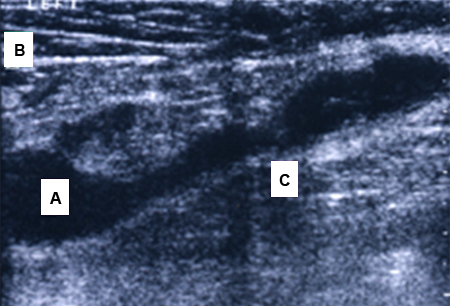Summary
Definition
History and exam
Key diagnostic factors
- popliteal bulge
- knee pain
- leg swelling
- calf tenderness
Other diagnostic factors
- calf ecchymosis
Risk factors
- knee joint trauma
- underlying knee joint arthritis or synovitis
- underlying knee joint infection
- increasing age
诊断性检查
首要检查
- duplex ultrasound of the leg
需考虑的检查
- MRI of the leg
- CT scan of the leg
- x-ray of the knee
治疗流程
asymptomatic
symptomatic: initial treatment
symptomatic: refractory to initial conservative treatment
撰稿人
作者
John D. Kelly IV, MD
Professor of Clinical Orthopaedic Surgery
Director of Sports Shoulder Service
Orthopaedic Surgery
University of Pennsylvania
Philadelphia
PA
利益声明
JDK declares that he has no competing interests.
鸣谢
Dr John D. Kelly IV would like to gratefully acknowledge Dr Antonios P. Gasparis and Dr Nicos Labropoulos, previous contributors to this topic.
利益声明
APG declares that he has no competing interests. NL is the author of multiple references cited in this topic.
同行评议者
Brian Sabb, DO
Clinical Lecturer II
Orthopedic Radiologist
Department of Radiology
University of Michigan Medical Center
Ann Arbor
MI
利益声明
BS declares that he has no competing interests.
Hill Gaston, MA, PhD, BM BCh, FRCP, FMedSci
Professor of Rheumatology
University of Cambridge
Clinical Director
West Anglia CLRN
Cambridge
UK
利益声明
HG declares that he has no competing interests.
Richard Wakefield, BM, MRCP, MD
Senior Lecturer in Rheumatology
Academic Section of Musculoskeletal Disease
Leeds Institute of Molecular Medicine
Chapel Allerton Hospital
Leeds
UK
利益声明
RW declares that he has no competing interests.
Peer reviewer acknowledgements
BMJ Best Practice topics are updated on a rolling basis in line with developments in evidence and guidance. The peer reviewers listed here have reviewed the content at least once during the history of the topic.
Disclosures
Peer reviewer affiliations and disclosures pertain to the time of the review.
参考文献
关键文献
Labropoulos N, Shifrin DA, Paxinos O. New insights into the development of popliteal cysts. Br J Surg. 2004;91:1313-1318. 摘要
Chatzopoulos D, Moralidis E, Markou P, et al. Baker's cysts in knees with chronic osteoarthritic pain: a clinical, ultrasonographic, radiographic and scintigraphic evaluation. Rheumatol Int. 2008 Dec;29(2):141-6. 摘要
American College of Radiology. ACR appropriateness criteria: chronic knee pain. 2018 [internet publication].全文
参考文献
A full list of sources referenced in this topic is available to users with access to all of BMJ Best Practice.

鉴别诊断
- Deep vein thrombosis (DVT)
- Popliteal hematoma
- Popliteal muscle tear
更多 鉴别诊断指南
- Appropriateness criteria: chronic knee pain
更多 指南登录或订阅即可浏览 BMJ Best Practice 临床实践完整内容
内容使用需遵循免责声明
